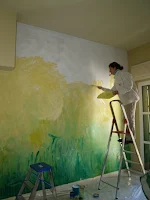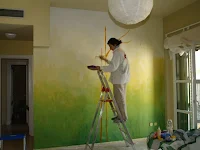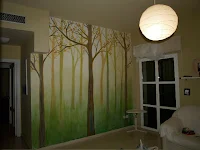Mi hija Anna pedía desde Navidad un "mercadito" para jugar y no encontrabamos ninguno adecuado para ella. O bien eran muy inestables, o ocupaban mucho espacio o se salían de presupuesto.
Mi marido y yo no solemos hacer bricolage juntos. Nunca habiamos hecho nada más allá de montar algún mueble en casa, con sus instrucciones, sus piezas, sus herramientas... todo incluido.
Y derepente, se acercaba el cumpleaños de Anna, y seguiamos sin haber encontrado nada y la niña sólo pedia su mercadito. Cada vez que le preguntabas.
Así que nos pusimos a la obra.
Tras hacer una busqueda exhaustiva en internet de mercaditos, vintage, comercializados y caseros, decidimos hacer un mix de todo lo que habiamos visto (En pinterest tengo un board entero publicado con esto y más juguetes de madera si le quereis echar un vistazo)
El más similar sea quizás este
Y finalmente, esto es lo que salió :)
 La estructura:
La estructura:Partimos de la estantería Ivar de Ikea (podría valer cualquier otra estanteria que tengais o que veais por ahí) porque nos venía bien de tamaño y de precio y nos pareció fácil de manipular.
Elegimos una estantería, entre todos los soportes posibles para hacer el mercadito, con la idea de poderlo reutilizar más adelante para libros, cuando ya no jueguen con él.
Compramos a parte, en unos almacenes de bricolage, dos tablones de madera de pino sin tratar de la misma medida que los de Ivar, listones y barras de madera, cola de carpintero, enganches para las barras de los armarios y una tela de rayas rojas y blancas.
La tela de lunares ya la tenía yo en el taller.
También usamos unas escuadras que habían sido soportes de una estantería en mi taller y ya no se usaban.
Empezamos por cortar las baldas extra a medida. Para que quedara bien y estable, cortamos las esquinas de los tablones con la forma en esquina de los listones verticales de la estantería y sesgados para montarlos inclinados. Los atornillamos en su sitio.
Después de esto, hicimos unos agujeros de fresa en los listones verticales de la estantería, para poder encajar en ello dos de las barras de madera. Ambas en realidad, para dar mayor estabilidad al conjunto. Una la colocamos unos 5cm del mostrador y la otra arriba, por debajo de la última balda.
Siento no tener foto de esto. No sé si lo podeis apreciar en las otras fotos.
Luego montamos el resto de la estantería tal cual (dos secciones laterales y dos baldas) poniendo la primera balda a la altura adecuada para la niña (El mostrador por así decirlo) y la otra casi arriba del todo, que sirve de pequeño almacén.
Encajamos las barras en sus huecos respectivos.
Una vez montada la estructura, pegamos a las baldas inclinadas unos listoncitos que hacen de tope para que las cajas de "artículos para la venta" no se caigan rodando.
Lo dejamos secar.
El remate:
Primero hicimos la estructura del toldo. Colocamos las escuadras de madera en la parte frontal superior y le atornillamos los soportes de barra metálicos (de los que se usan en los armarios empotrados).
Colocamos las barras cortadas a medida. Una delante, en las escuadras, y otra detrás, directamente a los laterales de la estanteria.
Ahora venía lo dificil, que era montar la barra superior para que el toldo tuviera caida a dos aguas.
Y la solución apareció por casualidad, cuando al rebuscar en la caja de herramientas encontramos dos escuadras metálicas de no sé que mueble.
Nos salvó el proyecto, porque habiamos pensado hacer una estructura triangular con los recortes de las barras y listones pero era un lio tremendo y andabamos cortos de tiempo.
Una semana para el cumpleaños... nada más.
Y finalmente, sólo quedaba el toldo.
 Para
sacar el patrón, coloqué la estantería en el suelo y tracé en un
cartoncillo el contorno de la estructura para el toldo. Tomé las medidas
de ancho y largo del toldo y el largo del faldón y me puse a cortar telas.
Para
sacar el patrón, coloqué la estantería en el suelo y tracé en un
cartoncillo el contorno de la estructura para el toldo. Tomé las medidas
de ancho y largo del toldo y el largo del faldón y me puse a cortar telas.Para mi, lo más complicado fué hacer que encajaran bien la lona de rayas y el forrito de lunares que se me metió entre ceja y ceja poner....
No hace falta. No os ofusqueis como yo...
Y si qureis que os quede mejor que el mio, tened en cuenta el ancho de las rayas a la hora de calcular la medida de las ondas del toldo. El nuestro está un poco descuadrado º_0
 Para rematar y
sujetar el toldo a la estructura usé cinta de canutillo blanca y una
lazadita. Queda bien encajada y se puede quitar fácilmente para lavarla o
darle la vuelta para cambiar de negocio ;P
Para rematar y
sujetar el toldo a la estructura usé cinta de canutillo blanca y una
lazadita. Queda bien encajada y se puede quitar fácilmente para lavarla o
darle la vuelta para cambiar de negocio ;P
En fin, espero que os haya gustado, que os inspire y ayude si os animais a hacer un mercadito propio y que nos envieis las fotos de los que hagais para curiosear el resultado, las mejoras que haceis etc.
Desde luego, Anna y sus amigos la disfrutaron de lo lindo en el cumpleaños y ya no puedo tomarme el café en ningún sitio más de la casa (Anna siempre me vende galletitas y algún helado jaja)
My daughter Anna asked since Christmas for a "market Stall" to play and we could not find any suitable for her. Either they were very unstable, or occupied a lot of space or where out of budget.My husband and I do not usually do carpentry jobs together. We had never done anything beyond installing some furniture at home, with instructions, parts, tools ... all inclusive.
Suddenly, Anna's birthday was almost there, and we were still trying to find anything right for us and the girl begged for her market.
....Every time you asked.So we set to work!After making a thorough search on the Internet for toy markets, vintage, home made and trendy we decided to make a mix of everything we had seen (On pinterest I have a whole board posted with this and more wooden toys if you want to take a look)Perhaps the more similar is this one
So, finally, this is what came out from all this thinking and searching :)The structure:We started from Ikea's Ivar shelf (it could be any other shelf from any other shop or second hand) because it was good in size and price and found it easy to manipulate.We choose a shelf, among all other possible media to do the market stall, with the idea of being able to reuse it later for books, when they do not play with it anymore.We buyed in a hardware store two pine planks without treatment to the same extent as those of Ivar, wooden slats and rods, wood glue, hooks for closet rods and red and white striped fabric.
The polka dot fabric I already had it in my atelier.We also used some brackets that used to be supports for a shelf and were no longer used.We started by cutting the extra shelves to measure. To get it right and stable, we sawed the edges of the boards in the shape of the corner of the vertical slats and slanted it for mounting inclined. Then screwed in place.After this, we made holes in the vertical slats of the shelf to fit into thiem two of the wooden bars. Both ,actually, to give greater stability to the hole. One placed about 5cm above counter on the front and the other, below the last shelf on the back.Sorry I did not take this photo. I do not know if you can see in the other photos propperly.Then assemble the rest of the shelf as is (two side sections and two shelves) laying the first shelf at the right height for the girl (the counter so to speak) and the other near the bottom, which serves as a small store.We fitted the bars in their respective holes.Once the structure was assembled , we sticked slats to the sloping shelves to stop making the boxes for "items for sale" fall rolling.We leave it to dry.The final piece:First we did the canopy frame. We put wooden brackets on the front top and screwed the metal bar supports (like those used in wardrobes).We then cut the bars to size. One in the front, at the brackets, and the other behind, directly to the sides of the shelf.Now came the difficult part, who was mounting the top bar so that the awning had its triangle shapeAnd the solution came by accident when digging in the toolbox we found two metal brackets from don't know where.It saved the project, because we had planned to do a triangular structure from bits and pieces of wood but it would have been a terrible mess and we where short of time.A week for birthday ... nothing more.And finally, there was only the awning to be done.To make the pattern, I placed the shelf on the floor over a cardboard and traced the outline of the structure for the awning. I took the measures and started to cut fabric.For me, the hardest part was making the striped canvas and polka dots inlay fit toghether.. that got into my head and nobody could have made me think in another way of doing it.There is no need. Trust me ...If you want it to fit better than mine, keep in mind the width of the stripes of your fabric to the calculate the number and width of your canopy waves. Ours are a little untidy º _0To top and fasten the canopy to the frame I used white lace and to make a small bow. It is well fitted and can be easily removed for washing or turn it outside down to change business; P
Since then, Anna and her friends enjoyed a great time at the birthday and I can not take my coffee anywhere else in the house (Anna always sells cookies and some ice cream haha)
PS:
Anyway, I hope you enjoyed this post and that inspires and helps you to you try to make a little market on your own. And, please, if you do, send us photos of yours to post them, we are always curious of the results, the improvements you do, your different styles and so on
:D








































